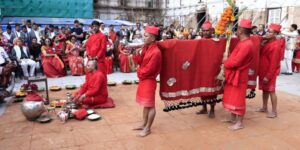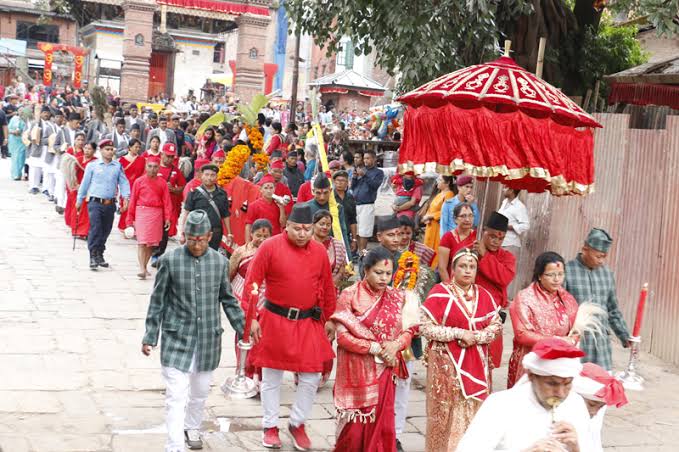Nepal: Phulpati – October 2, 2022, history significance
Phulpati (Phool Pati) is the seventh day of Dashain, the biggest Hindu festival in Nepal, and this year, it falls on October 2. The day is marked by honoring Goddess Durga with nine types of Phulpati (petals of flowers). The day celebrates the auspicious uncovering of truth over falsehoods and divinity over terror.
As per Hindu mythology, the nine plants represent the arrival of goddesses into the homes of the devotees. Hindu followers across the country decorate their homes with garlands and pray for a prosperous future under the guidance of Goddess Durga.
HISTORY OF NEPAL: PHULPATI

Dashain, one of the most auspicious festivals in Nepal, spans over 15 days. Locally pronounced as ‘Dasai,’ the festival is commonly known as Vijaya Dashami in India and is celebrated by Hindus around the world. The most auspicious of all fifteen days are the first, seventh, eighth, ninth, tenth, and fifteenth.
The Nepali Hindus celebrate Phulpati on the seventh day of Dashain. The story of Dashain is about the triumph of Goddess Durga over the demon Mahisasur.’ Over 10 days, the war waged between the two ended with the victory of Goddess Durga.
The day is marked by a joyous celebration across the country. The young children of the house dress up in new attire, and the kitchens are wrung up with one delicacy after the other.
Elders of the home prepare for the Phulpati puja, in which petals from nine different flowers are showered on the goddesses as they make their way to the homes of the devotees. On the eve of Phulpati, Nepal’s capital witnesses one of the most important ceremonies of the year.
A canon is fired from the Tundikhel, one of the largest grounds of Kathmandu, as Brahmins carry the royal Kalash stuffed with banana stalks, holy Jamara leaves, and sugar cane for the devotees to see. Offices across the nation of Nepal remain closed on the main days of the festival. Families get together to celebrate the day.
NEPAL: PHULPATI TIMELINE
2000 B.C.
The Birth of Hinduism
Hinduism is brought to northern Kathmandu Valley from the Indus Valley.
500 B.C.
Buddhism As A Religion
Monk Siddhārtha Gautama is born in Lumbini, Nepal.
1800 A.D.
The Malla Unity
Malla Dynasty flourishes the relations between Hindus and Buddhists of the region.
1950
The Rise of Hindu Theocracy
Hinduism strengthens in Nepal and the country turns a page from autocracy to democracy.
RECOMMEND STORIES
- Royal Challengers Bengaluru Clinch Maiden IPL Title with Thrilling 6-Run Win Over Punjab Kings
- Remembering Ratan Tata: A Visionary Leader and Compassionate Humanitarian
- National College Colors Day – September 2, 2024: history
- Bison-ten Yell Day – September 2, 2024: history, FAQs
- National Lazy Mom’s Day – September 6, 2024
HOW TO OBSERVE NEPAL: PHULPATI
Watch the ceremony
Every year, a grand ceremony takes place at the Tundikhel grounds in Kathmandu. A Kalash (pot) filled with freshly sprouted holy Jamara, sugar cane, and banana stalks are tied with a red cloth and brought to the Kathmandu Valley by the Brahmins. The event is witnessed by the President of Nepal and the entire government body and is live-streamed on the Internet.
Prepare dal bhaat
Dal bhaat is one of the most popular dishes in Nepal. An astonishingly healthy combination of steamed rice and cooked lentils — it is fairly easy to make and can be seasoned as per your preference. Mark the day of Phulpati by enjoying bowls of dal bhaat and getting a deeper knowledge of the cuisine of Nepal.
Plant a seed
On Phulpati, plant some seedlings in your backyard and await the reap the fruits of your labor in due season. Phulpati celebrates the sprouting of the holy Jamara seedlings that are planted at the beginning of Dashain. The fresh crop is later used in the ritual. The festival is a celebration of the birth of new things, propelled by our efforts and the grace of the nature that surrounds us.
5 EXHILARATING FACTS ABOUT LIFE IN NEPAL
Cultural museum of the world
Nepal has the highest concentration of UNESCO World Heritage Sites in the smallest area, totaling 15.
The arena of adventures
Nepal boasts of some thrilling adventures, including paragliding, white-water rafting, high-altitude marathons, kayaking, bungee jumping, and mountaineering.
A secular theocracy
Despite Hinduism being the national religion of the country, more than 80 ethnic groups coexist peacefully in Nepal.
A land of pot and potheads
Nepal, the formal home of Lord Shiva, is also famous for world-class quality weed, growing in almost all corners of the country.
The ironic water shortage
Nepal, the abode of lakes with many sources of freshwater, consistently suffers from droughts due to the disproportionate distribution of the resource.
WHY NEPAL: PHULPATI IS IMPORTANT
It brings communities together
The festival of Dashain is one of the best times to be in Nepal. Funfairs (mela), eateries, and clothing pop-ups open across the towns and cities in the country, and people splurge on shopping and experiences. Communities come together for two weeks of frolic. Trains and buses run full as people from all over the country travel to their hometowns to be with their families.
It’s a day to make merry
Millions of Nepali Hindus enjoy the joyous festival with their families. Homes are decorated with garlands and special lighting, and feasts are prepared on all 15 days of Dashain. The day of Phulpati, in particular, is celebrated with unparalleled fervor by people of all generations.
It celebrates the fruits of labor
Dashain begins with the ritual of sowing seeds on the first day of the festival, i.e., Ghatasthapana. By the seventh day, the seeds take the sapling and grow as grass known as Holy Jamara, which marks the day of Phulpati. This is a celebration of the turn of the season and is a symbolization of how the seeds we sow today beget the fruits we shall reap tomorrow.








